Dell U2412M - 16:10 IPS without Breaking the Bank
by Chris Heinonen on February 28, 2012 9:00 AM ESTDell U2412M Color Quality
With that long write-up out of the way, you might expect that there was something in particular to the U2412M that led me to explain our testing and results. There initially was but it actually proved to be a software issue; still, I thought the explanation on the previous page would be useful for everyone. For our uncalibrated measurements, I used the profile included on the CD, set the brightness to 200 nits, and then measured using the i1Pro meter.
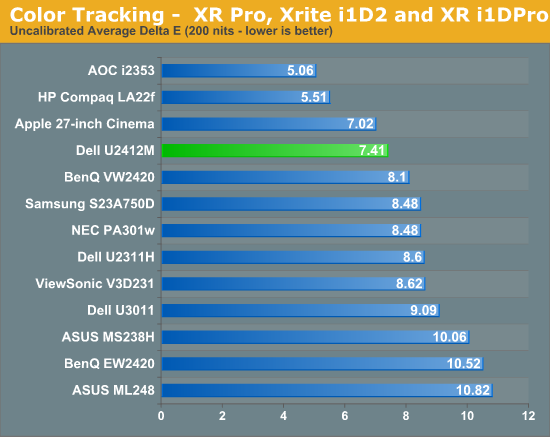
Here we see a score over 7, which is about what we expect to see on a monitor straight out of the box. Comparing this to previous displays isn’t easy to do as most of those used the i1Display2, which isn’t nearly as accurate as the i1Pro is. Of course, all displays do better once calibrated, so I kept the brightness target at 200 nits, with a white point target of D65, gamma of 2.2, and minimum black target.
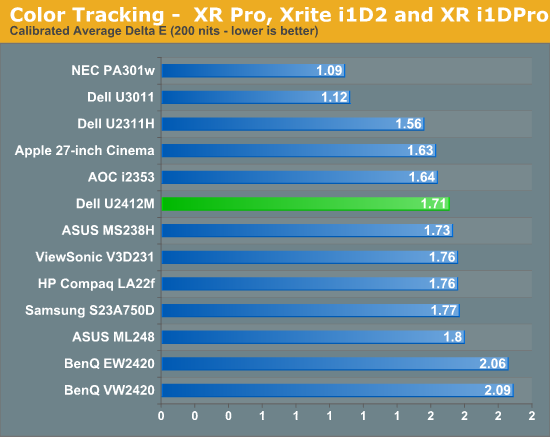
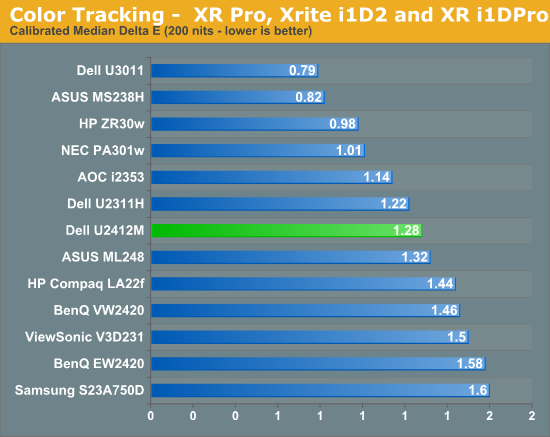
The errors for the Dell look very similar to what we have seen on other monitors. The color gamut is not AdobeRGB, so some of the patches are outside of the range for the display and can’t be rendered correctly. This leads to the spikes in the chart for blue samples and the higher average dE. We included the median dE number so you can see that the value drops quite a bit if we look at that. Everything other than blue is pretty good, and the grayscale is right around 1. So this is nice overall, though not perfectly accurate due to the color gamut and possibly due to the 6-bit panel. Now we will profile again to see if the results are similar with a target of 100 nits instead of 200 nits.
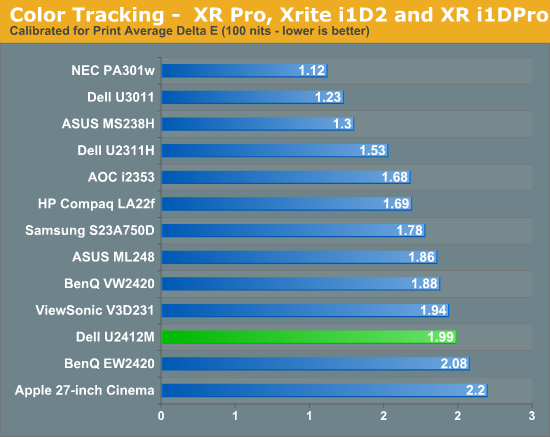
The error seems to rise a bit here, most notably in the grayscale that you would want to keep very neutral for print work. Most colors stay below 3.0 in their error (which is considered the threshold of being visible to the naked eye in motion) but again the blues are past that and errors would be visible to someone that was looking. For serious print work, you probably need to look for something that can use the full AdobeRGB gamut.



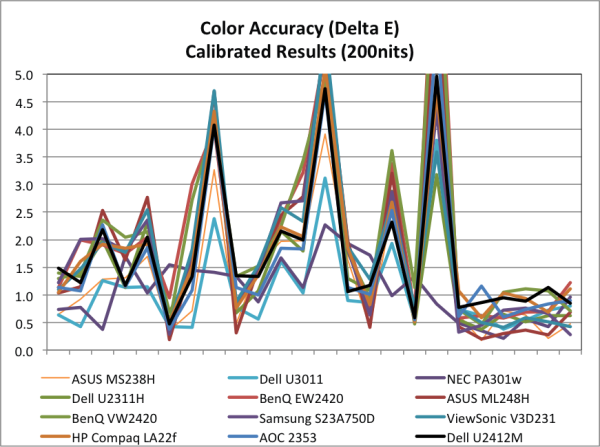
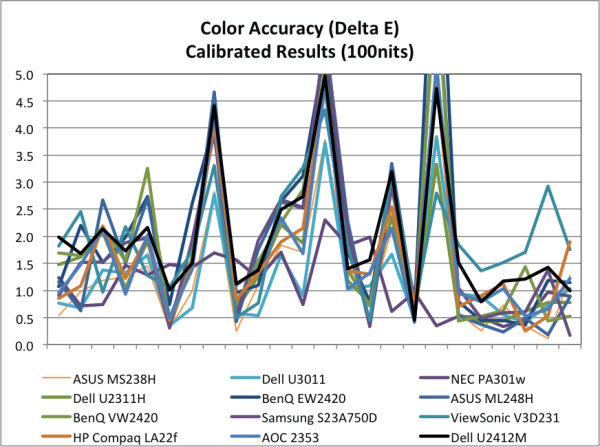








143 Comments
View All Comments
Death666Angel - Tuesday, February 28, 2012 - link
Honestly, if I had to chose between 16:9 with 1080p or 16:10 with 900p, I'd take 16:9. The real issue people argue is that the 24" market has gone 16:9 with 1080p. No gamer or other user would go with anything below 22" unless there are space constraints.piroroadkill - Wednesday, February 29, 2012 - link
The U2410 is not a budget screen by any measure, though, and although it is "old", it is not actually old. It is still being sold alongside the U2412, because the U2410 has a true 8-bit S-IPS panel, 10-bit processing, wider gamut (almost all of AdobeRGB) and a slew of inputs.It's still relevant.
seapeople - Wednesday, February 29, 2012 - link
Dude, nobody cares about your low resolution 16:10 screens.Only very strange aspect ratio freaks think 1440x900 is better than 1920x1080 anyway.
It's cool to see a budget 1920x1200 monitor out there.
Burner.Tom - Tuesday, February 28, 2012 - link
The direct competitor to reviewed Dell monitor is HP ZR2440w 24-inch LED Backlit IPS Monitor, not ZR24 - its the previous generation.PS: Dell isnt the LCD panel maker - its LG, probably model LM240WU8.
Burner.Tom - Tuesday, February 28, 2012 - link
HP ZR2440w 24-inch LED Backlit IPS Monitor - Overviewhttp://h18000.www1.hp.com/products/quickspecs/1414...
darwinosx - Tuesday, February 28, 2012 - link
The HP is a tad bit more expensive but a much better deal with much better service. I'm surprised the author didn't know this was actually the competitor for this Dell not the old HP monitor.cheinonen - Tuesday, February 28, 2012 - link
For competitors I was specifically search for other IPS/VA panels with 1920x1200 resolution that were within $75 (or 25%) of the price of the Dell. The only model that came up at the time of searching was the older HP, which is why it was listed. There are a lot of other 16:10 IPS/VA panels, but once you got past being within 25% of the price, I didn't consider them direct competitors anymore.Burner.Tom - Tuesday, February 28, 2012 - link
U2412M and ZR2440w are direct competitors from hardware point of view (LCD panel) but the price is really better in Dell case.In Slovakia, its 253€ for Dell and 350€ for HP, both have 36 months On-site warranty. The question is - why is HP so expensive? I guess there must be something cheaper used in Dell monitor (power circuit, controller board, ...). Who is OEM of the Dell? ZR24w and ZR2440w are made by Tatung.
JarredWalton - Tuesday, February 28, 2012 - link
Wait, what makes the HP a "much better deal"? I'd call service of HP and Dell monitors pretty close to equal, and the HP is $50 more for the lowest price I can find. 15% more is only "a bit more"? They're both eIPS AFAICT, so other than the nebulous "service and support" aspect, why would one be better than the other?Touche - Tuesday, February 28, 2012 - link
HP has more inputs, a scaler for 1:1, thus can be hooked up to consoles, and better RTC control. The latter makes it a bit more responsive, but former to have higher input lag. Comparing several reviews, HP tends to have better uniformity.